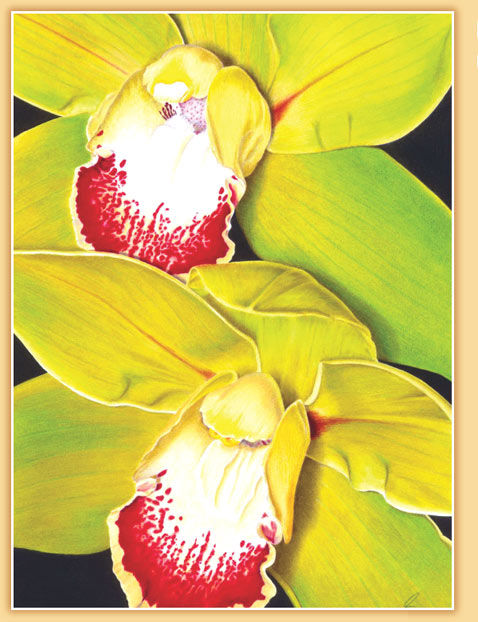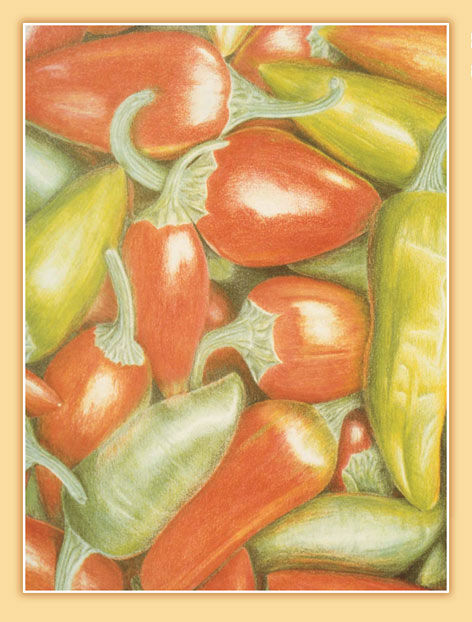introduction
One of the most consistent tools of expression for each of us has been the colored pencil. The day we received our first full box of assorted colors we felt grown-up, the passage from baby status to childhood was complete. The broken wax crayon stubbles were immediately thrown out to make way for the more elegant and mature pencils.
As time passed, their allure faded, too. These colored pencils were often the cheaper kinds, sporting hard leads and producing color that lacked the brilliance sought by our vivid imaginations. Despite their capacity for more exact line renderings, the emotional impact of the hues they imparted left much to be desired. Eventually, school introduced us to watercolors, which seemed to meet our undefined creative needs.
Towards adolescence (if not yet artistically discouraged), oil paints with their buttery sophistication pulled us away from the immaturity of pencils and watercolors. Working with oils was the sign of a real artist! We had finally reached, or so we thought, the most commonly accepted medium of professional stature.
Because childhood years are seen as lacking in maturity and sophistication, art tools used by children also are seen as unworthy of adult consideration. It is therefore difficult for us to separate materials from the process of maturity. We have been conditioned to view some art materials as infantile and others as adult.
Luckily, people who enjoy art do not adhere to such limited viewpoints. In the search for materials that will help us convey accurately our visions and perceptions, we often return to those tools with which we were most comfortable in childhood.
Great paintings have been produced in watercolor by some of the worlds finest artists, yet the value of these renderings has traditionally been considered to be less than those created in oils. Today, however, watercolor is beginning to get the recognition it deserves. Likewise, the colored pencil, in the past used primarily by designers and illustrators, is slowly being acknowledged as a valid tool of expression in the fine arts arena.
In presenting The Complete Colored Pencil Book, I wish to offer every reader a glimpse into the world of a versatile and vibrant medium, one that hopefully brings back fond childlike memories. At best, I hope the rediscovery of colored pencils will be an inspiring one. Colored pencils have evolved greatly. The spontaneous application of rich, deep colors will certainly enthrall those of you who find the combination of drawing and painting an exciting exercise.

Bernard Aim Poulin
What You Need
COLORED PENCILS
artist- and student-grade
water-soluble
colored sticks
PAPERS
machine- and handmade
colored
watercolor
(hot- and cold-pressed) acid-free board
OTHER DRAWING SURFACES
wood
coated Mylar
coated vinyl
DRAWING TOOLS
spray fixative
tortillions
facial tissue
erasers
(ink and pencil, gum, kneaded)
sharpening tools
(pencil sharpeners, blades, sandpaper block)
pencil holder
pencil extender
HB and B graphite pencils
graphite powder
soft graphite stick
knife, razor blade or craft blade
(for sgraffito)
acetate or onion skin paper
colorless blender
MISCELLANEOUS SUPPLIES
easel (collapsible)
bench (collapsible)
sketch box, fishing tackle box, or photographers vest
light table
armrest
reverse screen
slide projector/slides
camera with telephoto lens

chapter one
drawing tools
I wrote The Complete Colored Pencil Book to take you beyond those first hatches and crosshatches that piqued your interest in colored pencil artwork.
Though you may be a relative newcomer to colored pencils, you will be surprised at how exciting it is to extend your basic experiences into more elaborate and satisfying renditions.
But before crossing the next hatch in this adventure with colored pencils, take time to analyze the techniques and styles you generally practice. First, examine the tools you use.
Orchids
Gary Greene
choosing your materials
Like other mediums, colored pencils should be selected to suit your specific needs. The differing qualities of these carefully manufactured pencils will be explained in this chapter. Not all colored pencils are created for the purpose of fine artwork; some are produced for illustration or graphic art rendering.
It is important to know whether you enjoy producing graphically precise drawings, fluid-stroked fine art renderings or illustrations. Recognizing whether your work is soft, loose, precise, evocative or moody is an important consideration in the choice and application of colored pencils and their related accessories.












